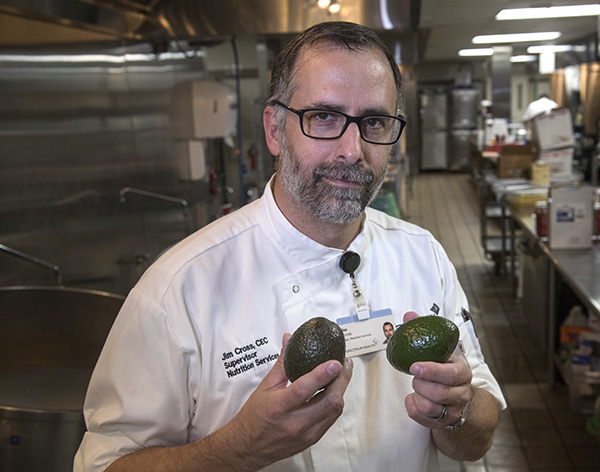Perhaps you’ve heard of “avocado hand”?
This self-inflicted injury has been in the news this year as plastic surgeons report an upsurge in patients who have cut themselves while slicing the popular green fruit.
Oscar winner Meryl Streep and kitchen queen Martha Stewart are both painfully familiar with avocado-related injuries.
Closer to home, so are two Spectrum Health employees, Kelly Agens and Jim Cross.
A tale of two pits

Cross, a certified executive chef, is the chef supervisor in the Spectrum Health Butterworth Hospital kitchens. He experienced avocado hand more than 20 years ago while working as a chef at the former Gibson’s Restaurant in Grand Rapids, Michigan.
He was using one of the tricks of the trade—cupping a halved avocado in his hand and striking the pit with the blade of his knife so he could twist it out—when the knife sliced all the way through the pit and lacerated the skin between his left thumb and index finger.
“Typically the pit’s really hard and the knife won’t go through it, but this pit was really, really soft,” he said. More commonly with this injury, the knife bounces off the pit and is deflected into the hand.
In addition, Cross said, cooks sometimes cut themselves on the palm while dicing an avocado in its skin. The knife can go right through to the hand.
When Agens had her mishap, it was another case of a soft pit. Agens, an event specialist with Spectrum Health Frederik Meijer Heart & Vascular Institute, was home fixing a supper of eggs with vegetables. She planned to top it off with some avocado slices, one of her favorite foods.
While cooking, she was on the phone with a friend and became distracted from the task at hand. After cutting the avocado in half, she tried to stab the pit with her knife, but the knife tip went through the pit—and through her hand near her ring finger.
“I kind of stood there for a minute and I looked down and realized that it was worse than I had anticipated,” she said. “So I bandaged it up and had a neighbor take me to the ER.”
She still feels foolish thinking about it, but she remembers the doctor who treated her in the Butterworth Hospital Emergency Department saying these kinds of hand injuries are common.
“It’s dangerous—avocados are dangerous,” she said, laughing.
Laughter aside, Agens’ injury could have been serious. Though she didn’t sever any tendons, she did suffer minor nerve damage and opted against having surgery to repair it. She still feels the aftereffects: a middle finger that tingles, four years after the incident.
Agens hasn’t worked up the nerve to slice another avocado since that day.
“It’s very unfortunate because I love avocados,” she said. “I’m hoping one of these days I’ll be able to work my way back up to it.”
Avocado safety tips
Given the avocado toast trend and the proliferation of avocado-based recipes, this odd-shaped fruit isn’t going away. And that’s a good thing. Avocados have great flavor and texture, and they’re a source of monounsaturated fat, a good fat.
So how can home cooks protect themselves from avocado hand?
Chef Cross offers 5 tips:
1. Take your time.
Whenever you’re working with a knife, you don’t want to be in a hurry.
2. Use a sharp knife.
“The duller the knife, the more force you have to use,” Cross said. “And the more force you use, the less control you have over that knife.”
3. Cut on a cutting board, not in your hand.
Consider this tip Cross learned from a New York butcher: Always imagine where the knife would go if the product you’re cutting weren’t there. There’s always a chance of something giving way and the knife going straight through. “And wherever it ends up, it ends up,” he said.
4. Rest the avocado in a folded wet cloth.
This will keep the avocado from rolling around on the cutting board. Cut through it horizontally, spin it to complete the slice, lay down your knife, twist the halves apart, put the half with the pit back on the folded cloth, pick up the knife and tap the blade into the pit, then grab the avocado and carefully twist the knife to pop out the pit. (Lay the knife flat on the cutting board with the pit hanging over the edge, and pull the handle back to dislodge the pit from the blade.)
5. Use a spoon.
If you’re afraid to tap your knife into the pit, scoop it out with a spoon. You can also use the spoon to crosshatch the avocado in the skin instead of dicing it with a knife. Then just scoop out the contents.
While these methods may take a little extra effort, they’ll spare you the pain and difficulty of an unavoidable injury—so you can eat your guacamole in good health.
 /a>
/a>
 /a>
/a>
 /a>
/a>
Tell your two employees and others that Bed Bath and Beyond makes an avocado tool that cuts and removes the pit without having to use a knife. Have them reply to my email and I will send a picture.